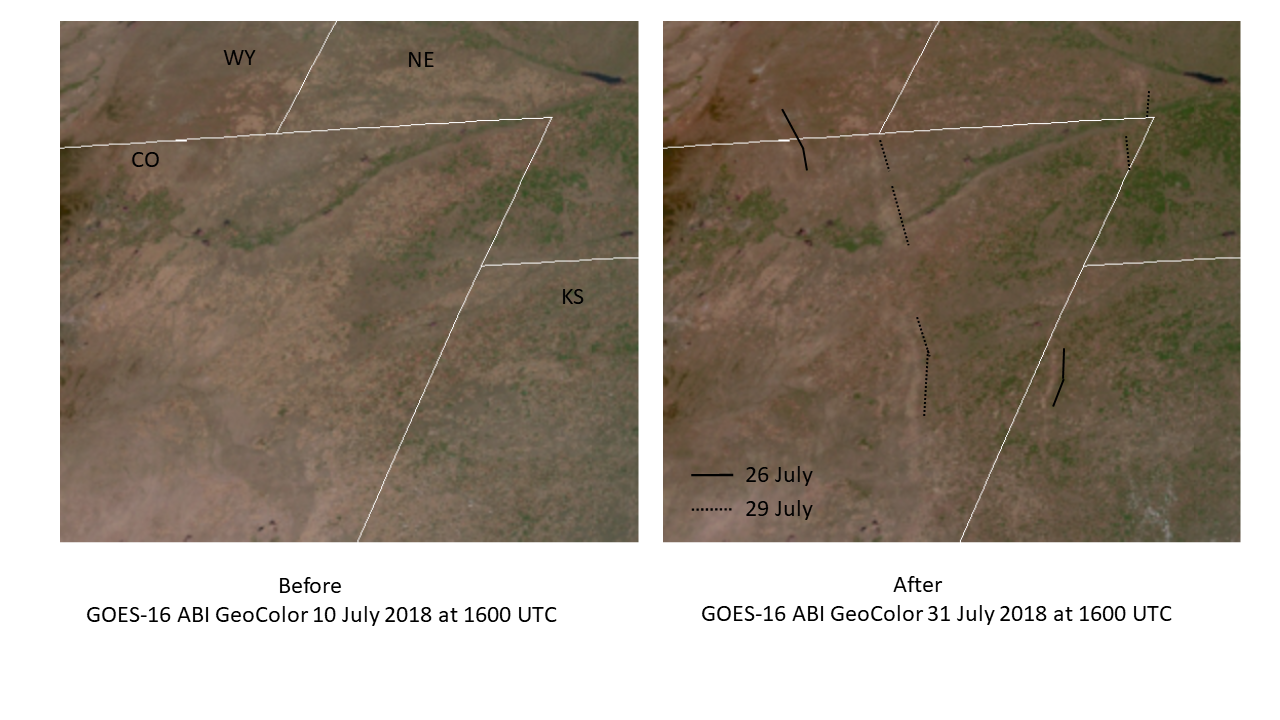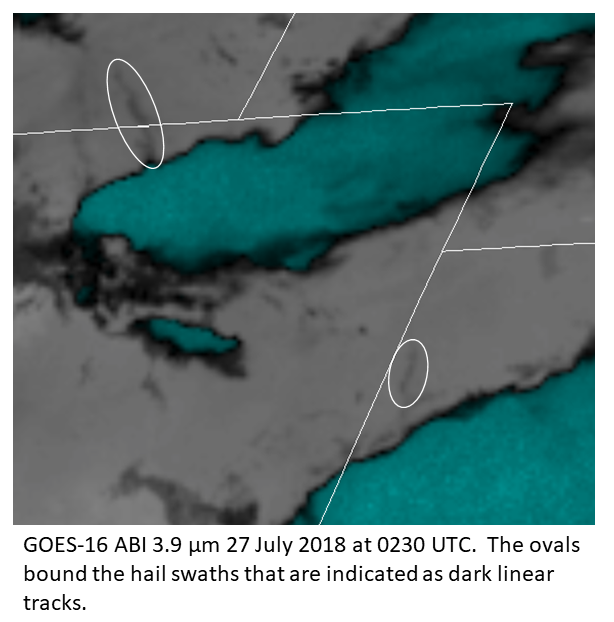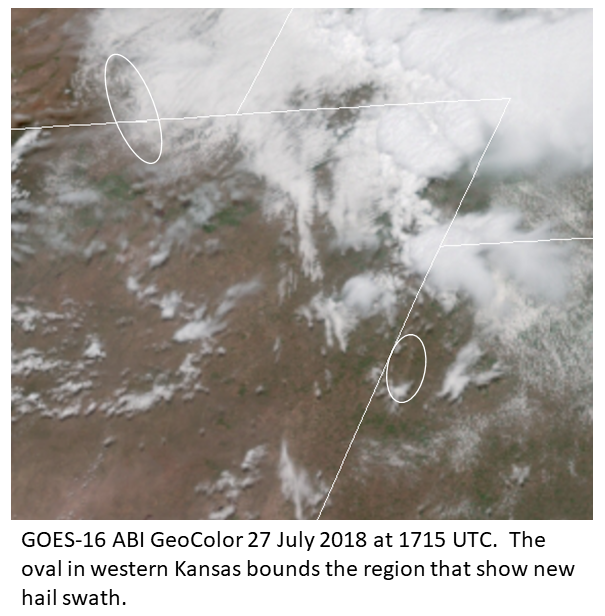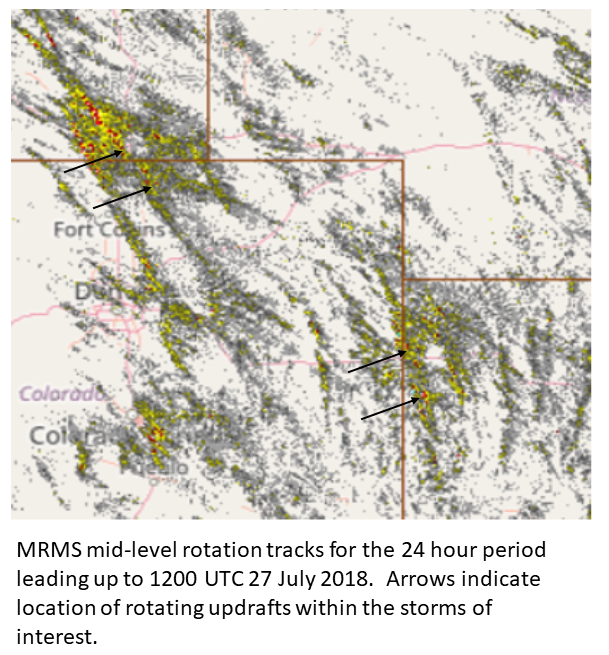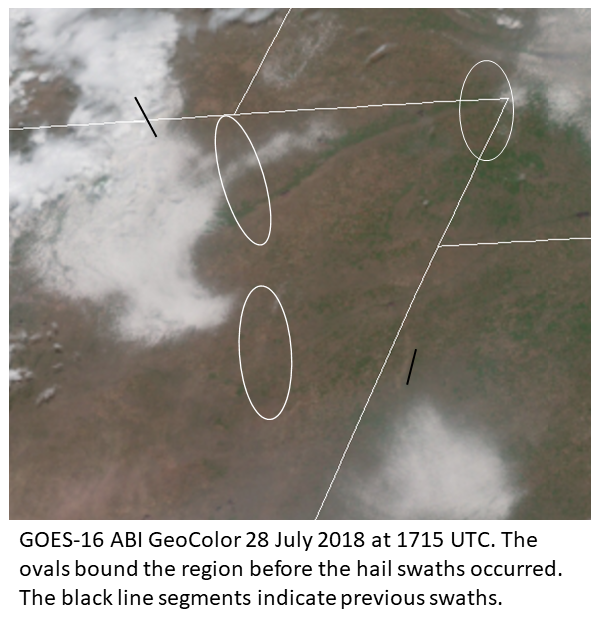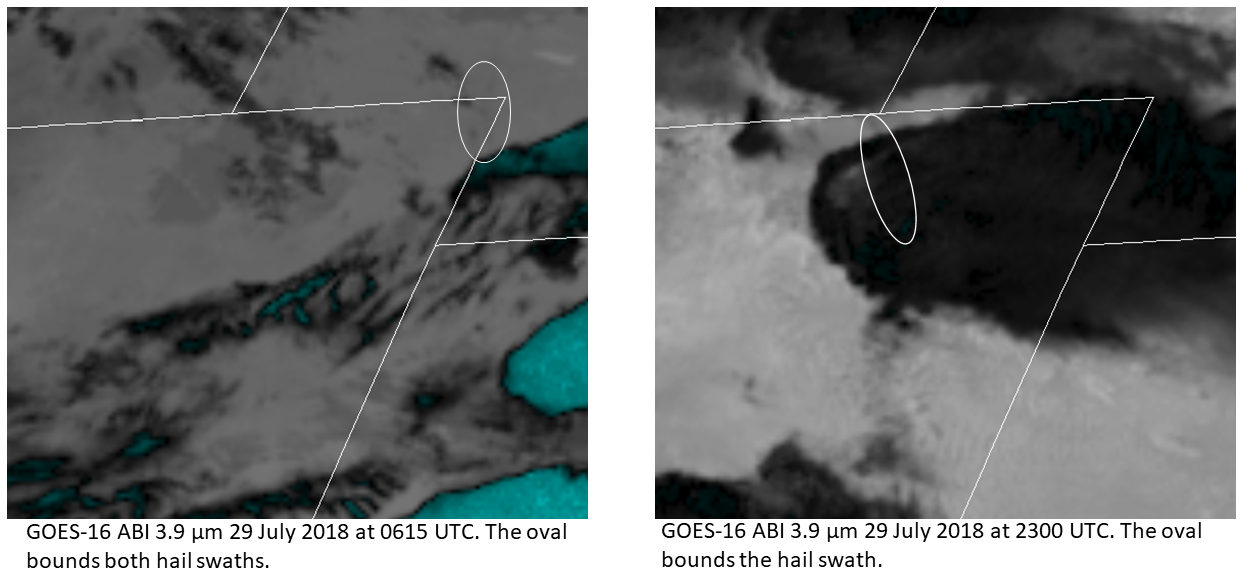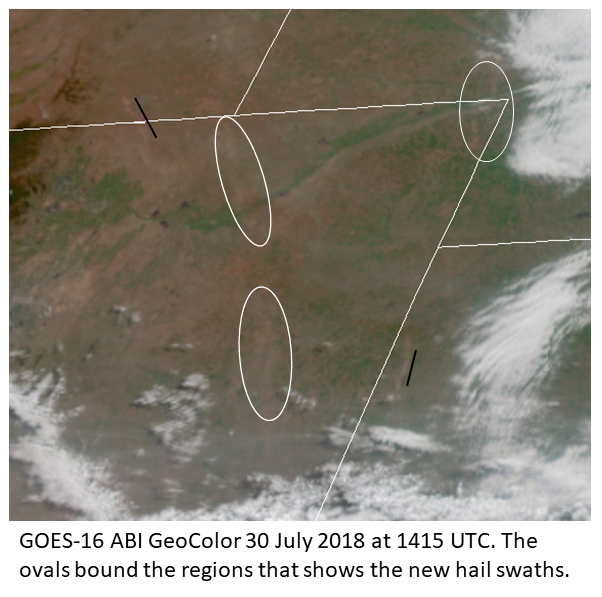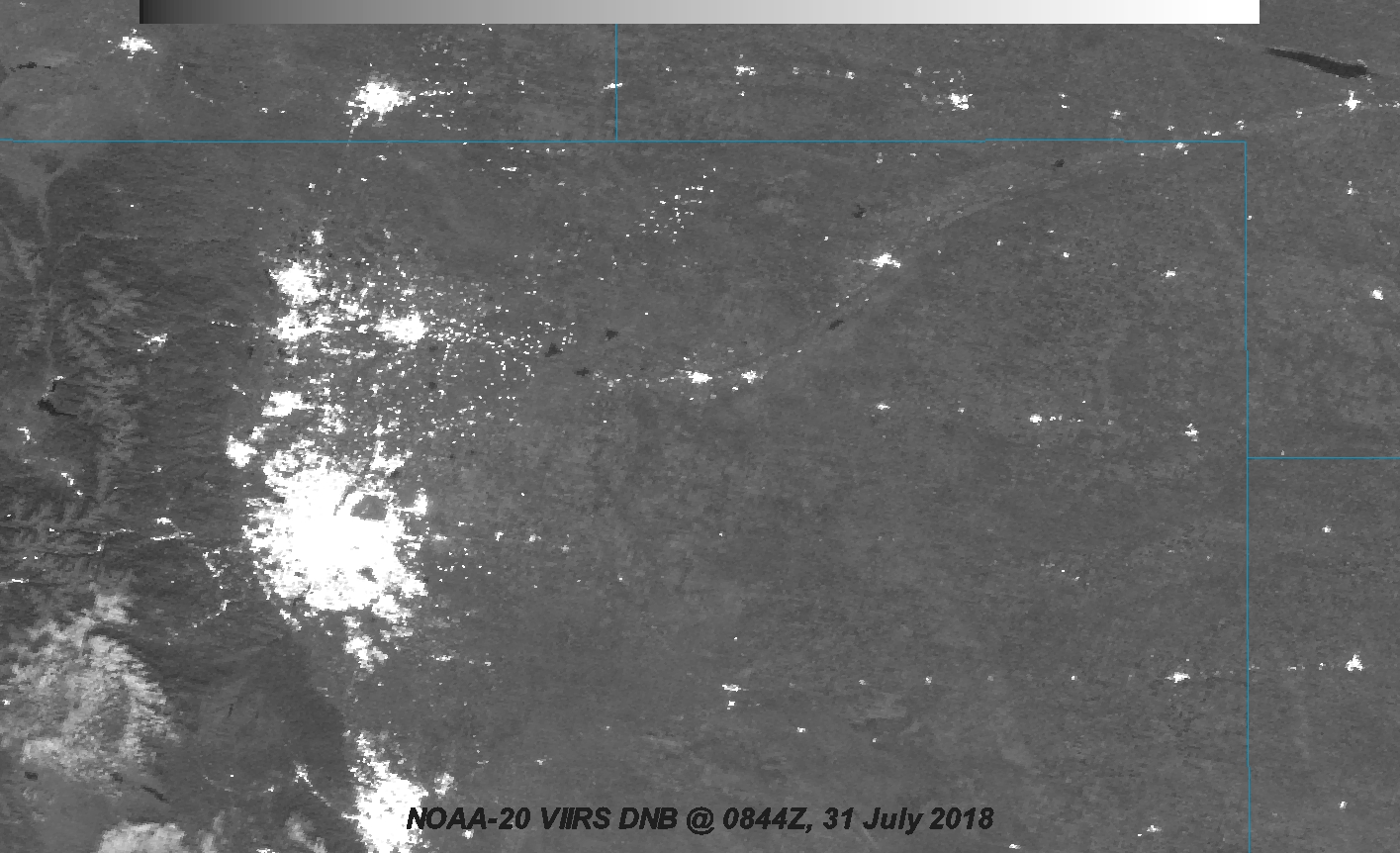Hail damage swaths from severe storms over the High Plains as viewed from satellites during July 2018
October 2nd, 2018 by Dan BikosBy Louie Grasso, Dan Bikos, Jorel Torres and Ed Szoke
During the summer of 2018 over the High Plains, several significant severe storms occurred. Several hailstorms moved southward over the Central High Plains and produced noticeable hail swaths and damage scars on the ground that were captured by GOES-16 ABI. The purpose of this blog is to compare and contrast GOES-16 imagery before and after each event. In addition, SNPP and NOAA-20 imagery will be shown that also contains damage scars. Supplemental observations of the tracks of the severe storms is provided the MRMS Mid-level rotation tracks along with SPC storm reports.
To begin with, a brief discussion of imagery before and after the hail swaths and damage scars is given below. Before the events (left side image in the figure below) this is how the GOES-16 ABI imagery appeared on 10 July 2018. For those not familiar with the region displayed in the imagery, the dominant brownish color is typical due to the semi-arid climate of the western High Plains. During the three weeks following 10 July a persistent northwesterly flow pattern existed that supported multiple severe weather episodes. As a result, several surface features, indicated by black line segments are evident at the end of the period (right side image in the figure below).
Our first case study occurred on 26 July 2018. Thunderstorms began developing during the afternoon of the 26th, a few of which are seen in the figure below. Of particular interest are the two white ovals, one located along the Colorado/Wyoming border, the second located in western Kansas. At that time no hail swaths were evident in either oval. A comparison of the figures above and below can be used to orient the reader about the 2 regions just discussed.
At 0230 UTC 27 July two hail producing storms were evident in imagery in the GOES-16 ABI 3.9 micron band and is displayed below. Within the white ovals, darker line segments were evident in the wake of the storm paths as they moved towards the southeast. In the color table used below, the dark line segments correspond to cooler brightness temperatures compared to the light gray region around each swath. The colder and dark line segments represent hail swaths due to the hail be colder than surrounding ground.
On the next day, imagery near noon is used to indicate the hail scar due to the previous day’s storms. Unluckily the swath along the Colorado/Wyoming was obscured by persistent clouds. On the other hand the swath in western Kansas is evident within the oval: compare the figure below with the previous two figures.
An independent observing system that captured the storms is the MRMS mid-level rotation tracks. As is seen in the figure below, the pairs of black arrows correspond to the location of rotating storms. A comparison of the figure below with the previous three figures above provide additional evidence of convective activity where the hail swaths occurred.
Our second case study occurred on 28 July 2018. Unlike the first case above, no thunderstorms have developed in the image below since it is late morning. Of particular interest are the three white ovals, one located just south of the Colorado/Wyoming border, the second located in extreme northeast Colorado, while the third is located over east central Colorado. At that time no hail swaths were evident in either oval. A comparison of the first figure (see beginning of blog) and the figure below can be used to orient the reader about the 3 regions just discussed.
At 0615 UTC 29 July the hail producing storm was evident over extreme northeast Colorado as seen in the GOES-16 ABI 3.9 micron band imagery as displayed below on the left. Within the white oval in extreme northeast Colorado, two darker line segments were evident in the wake of the storm path as it moved towards the southeast over extreme southwest Nebraska. Later on that day, severe storms developed and also produced a hail swath; the northern portion of the hail swath is seen in the northern portion of the white oval near the Colorado/Wyoming border. The thunderstorm producing the hail swath covers the rest of the oval as is seen in the figure below on the right.
On 30 July 2018 at 1415 UTC imagery in the early morning is used to indicate the hail scars due to the previous two convective events (see figure below). The hail damage scars from the first case are denoted by two black line segments. Within each oval, hail damage scars are evident. A comparison of the figure below with the first figure of the blog can be used to help the reader identify hail damage scars.
As in the other case, the MRMS mid-level rotation tracks are used an additional source of information. As is seen in the figures below, the pairs of black arrows correspond to the location of rotating storms. A comparison of the figures below with the previous figures for this case provide additional evidence of convective activity where the hail swaths occurred.
All of the hail damage scars were also imaged by SNPP-VIIRS as seen in the image below on 31 July 2018 at 1917 UTC. Black arrows point to scarring locations while the white arrow points to Cheyenne, WY.
We leave it to the interested reader to identify hail damage swaths in the NOAA-VIIRS Day Night Band image displayed below. Also of interest a number of cities appear in the imagery.
Posted in: Convection, GOES R, Hail, POES, Satellites, Severe Weather, | Comments closed
Some Advected Layered Precipitable Water (ALPW) Comparisons Between Florence, Harvey (2017), Maria (2017) and Matthew (2016) with Respect to Rainfall and Severe Weather
September 24th, 2018 by Dan BikosThis blog entry is by Sheldon Kusselson and in the format of a PDF document:
Florence 2018 Comparisons With Harvey and Matthew and More_Sep21,2018update
Posted in: Heavy Rain and Flooding Issues, Hydrology, Severe Weather, | Comments closed
Hurricane Florence
September 10th, 2018 by Jorel TorresThe hurricane season in the Atlantic has been quite inactive throughout the majority of the summer, until this past week. Currently there are three active hurricanes located in the eastern, central and western Atlantic Ocean, named Hurricane Helene, Isaac, and Florence, respectively; all with varying magnitude, intensity, and storm tracks. However, with all the present activity, we will focus our sights on Hurricane Florence, since Florence can have major impacts (i.e. flooding, high winds, storm surge and potential power outages) along the southeastern United States. According to the latest forecast models and National Hurricane Center (NHC), Hurricane Florence appears to make landfall along the Carolinas, Thursday morning, 13 September 2018, although the storm track is subject to change, since it is only Monday, 10 September 2018. Refer to the NHC product below. Note that Florence is anticipated to become a Major Hurricane (i.e. hurricane greater than 110 mph) as it makes landfall later in the week.
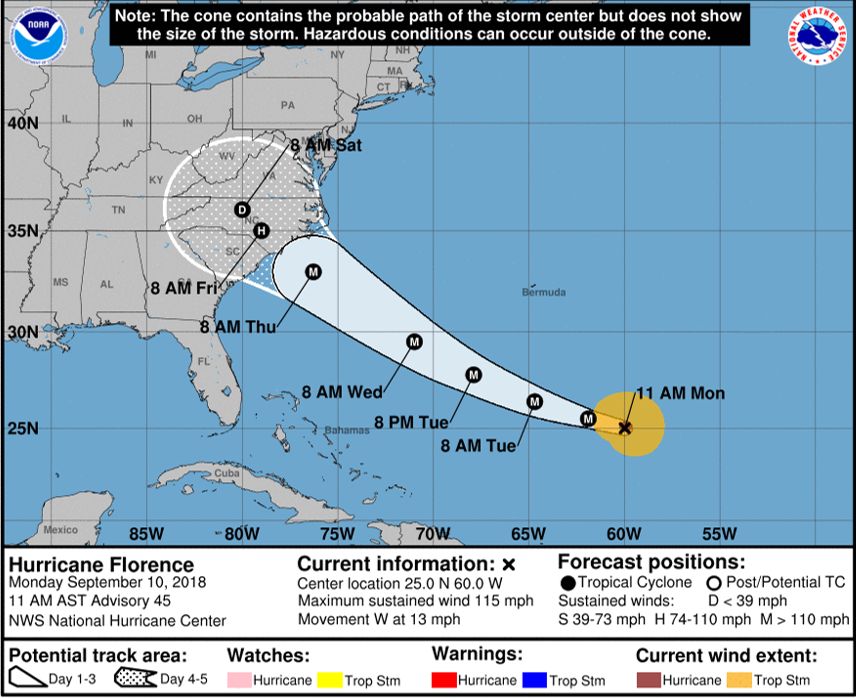
The Suomi-National Polar-orbiting Partnership (S-NPP) satellite observed Hurricane Florence early this morning at 0505Z, 10 September 2018, using the Near-Constant Contrast (NCC) product. For unaware readers, NCC is a derived product of the Day/Night Band (DNB) that utilizes a sun/moon reflectance model that illuminates atmospheric features, and senses emitted and reflected light sources during the nighttime (i.e. a ‘nighttime visible’ product). Note the NCC imagery is taken during the new moon phase of the lunar cycle, where atmospheric features are still seen in the imagery due to an atmospheric phenomenon called ‘atmospheric nightglow’.
NCC captured the large areal extent of Hurricane Florence, along with the eyewall, circulating clouds and rain bands. Lightning was also observed on the southern side of the hurricane, denoted by the horizontal white streaks. Streaks are produced due to the time discontinuity between the satellite overpass (i.e. on the order of seconds) and the duration of the lightning strike (i.e. on the order of milliseconds).

Below, is a CIRA ALPW surface-850mb animation of the hurricane activity in the Atlantic Ocean between 18Z, 9 September 2018 to 15Z, 10 September 2018. The ALPW product highlights the precipitable water (i.e. a quantifiable measure of how much water vapor is in an atmospheric column) within four layers of the atmosphere (i.e. surface-850mb, 850-700mb, 700-500mb, and 500-300mb). Notice the high precipitable water values with each hurricane (i.e. indicating the horizontal moisture distribution and indicate areas that are favorable for heavy precipitation) as the hurricanes move westward through time.
For the latest updates on Hurricane Florence, click the following link.
Posted in: Tropical Cyclones, | Comments closed
Hurricane Lane
August 23rd, 2018 by Jorel TorresHurricane Lane is making headlines this week, as the storm approaches the Hawaiian islands. As of the latest National Hurricane Center (NHC) update (8 am HST, 23 August 2018), Lane is moving quite slow, with a northwest movement at ~ 7 miles per hour. Within the last day or two, Lane has weakened, but is still a Category 4 hurricane that can bring heavy precipitation, high winds, storm surge and coastal flooding. Some parts of the Hawaiian islands have experienced heavy precipitation already, and more is expected, throughout the next few days. As seen in the NHC image below, the forecasted track shows the ‘probable path’ of Hurricane Lane, but does not indicate the magnitude of the storm. The forecasted track is subject to change.
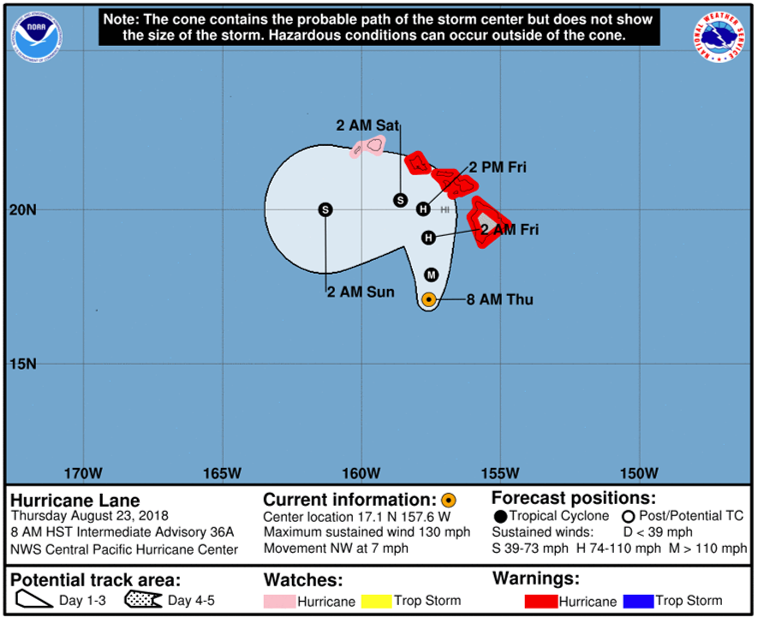
The Suomi-National Polar-orbiting Partnership (S-NPP) satellite observed Hurricane Lane via Near-Constant Contrast (NCC) product, earlier this morning at 1228Z, 23 August 2018. The NCC is a derived product of the Day/Night Band (DNB) sensor, that illuminates atmospheric features and senses emitted and reflected light sources (i.e. cloud cover and cloud convective tops from Lane) during the nighttime. In the NCC image, notice the large areal extent of Hurricane Lane, as the northern/northeastern periphery of the storm has reached the southern shores of the Hawaiian islands, bringing heavy precipitation rates.

In complement to the NCC, the CIRA -Advected Layered Precipitable Water (ALPW) product (shown below), derived from microwave retrievals, shows high precipitable water values of Hurricane Lane, as the storm moves northwestward. The ALPW product is partitioned into 4 layers, to identify where most of the moisture lies within the atmosphere, and indicates the horizontal moisture distribution. In the animation below, ALPW highlights ‘surface-850mb layer’ precipitable water values, where high values are concentrated within and near Hurricane Lane (orange, dark orange colors), indicating areas that could experience heavy precipitation. Precipitating regions are indicated as ‘missing data’, represented by black colors in the imagery, since microwave retrievals are made in cloudy regions but not precipitating regions. Animation is from 18Z, 22 August 2018 to 15Z, 23 August 2018.
For the latest updates on Hurricane Lane, click on the following NHC link.
Posted in: Tropical Cyclones, | Comments closed
Hurricane Hector
August 9th, 2018 by Jorel TorresHurricane Hector has been a ‘Major Hurricane’ in the Central Pacific for the past week. At one point, the hurricane was nearly categorized as a Category 5 hurricane, however weakened, and is currently a Category 3 hurricane (i.e. ~120 mph winds as of 8AM Hawaiian Standard Time (HST), 9 August 2018). The storm is moving west at ~16 mph, and was ~350 miles southwest of Hawaii.
Polar-orbiting satellites observed Hector, earlier this morning, via the Near-Constant Contrast (NCC) and the Advected Layered Precipitable Water (ALPW) satellite products. The NCC, a derived product of the Day/Night Band (DNB) sensor, utilizes a sun/moon reflectance model to illuminate atmospheric features, and sense emitted (i.e. city lights) and reflected (i.e. clouds) lights during the nighttime. NCC image is at 750-m spatial resolution and is taken at 1152Z (0152 local time), 9 August 2018, during the new moon phase of the lunar cycle. Imagery shows Hector’s large areal extent, eye wall, and cloud cover, along with nearby emitted city lights from the Hawaiian islands.

In complement to NCC, the ALPW product, derived from polar-orbiting satellites, highlights precipitable water values within 4 atmospheric layers, different from the Blended Total Precipitable Water (TPW) product. The ALPW animation below, shows one of the layers (surface to 850mb), where high TPW values are observed within Hector. High TPW values indicate large amounts of moisture within the surface-850mb layer that are then transported westward with respect to time (i.e. see animation). It is important to note, missing data values are observed in the imagery (i.e. black pixels), representing regions of precipitation. Animation is from 18Z, 8 August 2018 to 15Z, 9 August 2018, showing Hector’s westward movement as the hurricane skirts along the southern edge of the Hawaiian islands. So far, the islands have received some rainfall and high surf along its southern shores. ALPW product is at 16-km spatial resolution.
For more updates on Hurricane Hector, click on the following link.
Posted in: Tropical Cyclones, | Comments closed

